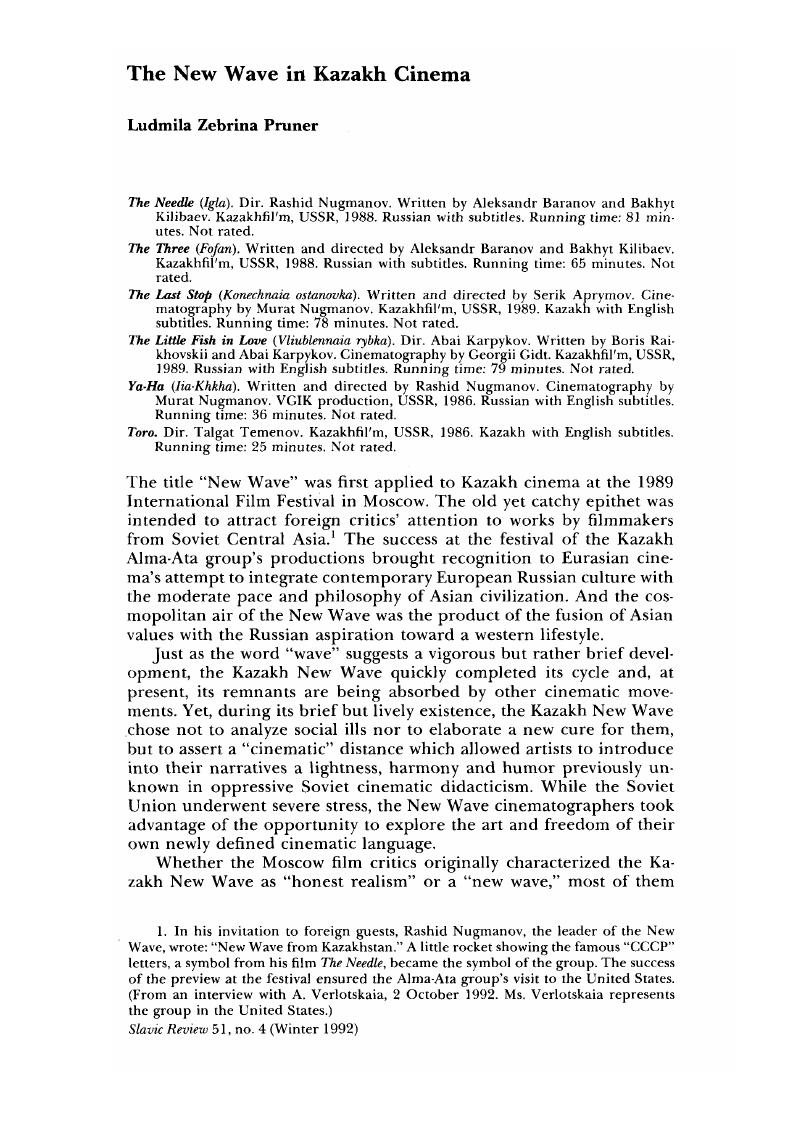Published online by Cambridge University Press: 27 January 2017

1. In his invitation to foreign guests, Rashid Nugmanov, the leader of the New Wave, wrote: “New Wave from Kazakhstan.” A little rocket showing the famous “CCCP” letters, a symbol from his film The Needle, became the symbol of the group. The success of the preview at the festival ensured the Alma-Ata group's visit to the United States. (From an interview with A. Verlotskaia, 2 October 1992. Ms. Verlotskaia represents the group in the United States.)
2. Aleksandr Shpagin, “Novaia volna?!,” Iskusstvo kino 9 (1990): 65-69; Serik Apryraov, “Naperekor mifu,” ibid., 70-72; Nina Zarkhi, “Drugoe kino,” ibid., 72-75.
3. The Kirgizfilm Studio served as a launching pad for new Russian directors. For example, it offered the opportunity for the now well known and internationally recognized director Andrei (Andron) Mikhalkov-Konchalovskii to make his first film, The First Teacher (Pervyi uchitel', 1966) and for Sergei Urusevskii, the brilliant cameraman for Kalatozov, to direct his movie The Trotter's Gait (Beg inokhodtsa, 1968). The Kirgizfilm Studio also allowed a promising Russian woman director, Larisa Shepitko, to produce Heat (Znoi, 1968) and her second film, Wings (Kryl'ia, 1966). Many of the Kirgizfilm productions were based on works by the master of Russian prose, Chingiz Aitmatov. Among the first native filmmakers working at the Kirgizfilm Studio were Bolotbek Shamshiev and Tolomush Okeev, who made their artistic debuts in Shepitko's films before gaining recognition as directors.
4. Ciesol, Forrest, “New Wave Films From Soviet Kazakhstan,” Preview (Washington: American Film Institute, 1991): 13.Google Scholar
5. “Tysiacha i odna zabota,” Iskusstvo kino 4 (1990): 38-40.
6. The quest for the spiritual rebirth of the nation was initiated by the Soviet intelligentsia in the newspaper Sovetskaia Kultura in the late 1980s. The terms used more often were “ecology of human spirit” (ekologiia dukha chelovecheskogo) and “ecology of culture” (ecologiia kultury).
7. After five years of continuous and systematic unveiling of the dark past and rumination on the unhappy present, the entire Soviet movie industry and its audience were on the verge of a “nervous breakdown.” The repeated cinematic shock therapy contributed to the popularity of a “black” genre (chernukha) and the invasion of the Soviet movie market by cheap westerns, pseudo-martial art movies, pornography, sex and violence. The success of the “Rambo” series of films in the 1980s in Russia is an example. They offer a socialist-realist schema central to Soviet mass culture. Rambo has all the attributes of a positive hero: a man of unbreakable will, courage and pride who fights for a “common cause” and wins against all odds. Furthermore, Rambo personified action and victory to the paralyzed Soviet Union under Gorbachev. For almost two glasnost’ years, the entire Soviet Union was glued to television sets following the verbal duels of the ruling heroes and villains. The country craved action and Rambo provided a long-awaited catharsis.
8. Their diversity is reminiscent of the Serapion Brothers, a group of young writers of the 1920s who included almost all the creative minds of the post-revolutionary years before the advent of socialist realism. The writers who joined the group shared the pride of being different and free to create works of art. Their famous motto: “We are all different!” is echoed in Nugmanov's 1990 statement: “We demand no unified philosophy nor uniform artistic views on art. We are unified, instead, in our freedom and love of art” ( “Tysiacha i odna zabota,” hkusstvo kino 4 [1990]: 37).
9. Monaco, Paul, “Films, Myth and National Folklore” in Myth in Literature and Film (Tallahasee: University of Florida, 1980), 37.Google Scholar
10. In their book The Zero Hour (Princeton: Princeton University Press, 1992), A. Horton and M. Brashinsky interpret the word fofan as a misspelling of the English expression “for fun” (see p. 240). This treatment of the title is very appealing and easily fits the credo of the New Wave. It would be interesting to investigate whether the phonetic resemblance of the word to the English expression played any role in the selection of the title.
11. The resemblance between the two plots is further intensified by the scene with slaves. In Beckett's plot, Pozzo and his slave Lucky visit the vagrants. In Fofan, there is a similar scene. As the plot of Fofan moves the action to the location of a film shoot, we see that the director has hired the three men to dig trenches for the film production. While the men work, “slaves” from the film's cast pass through attached to each other by a rope. As they cross in front of the mesmerized vagrants, their overstated costumes make them appear ridiculous and yet the three men in the ditch below them look more out of place.